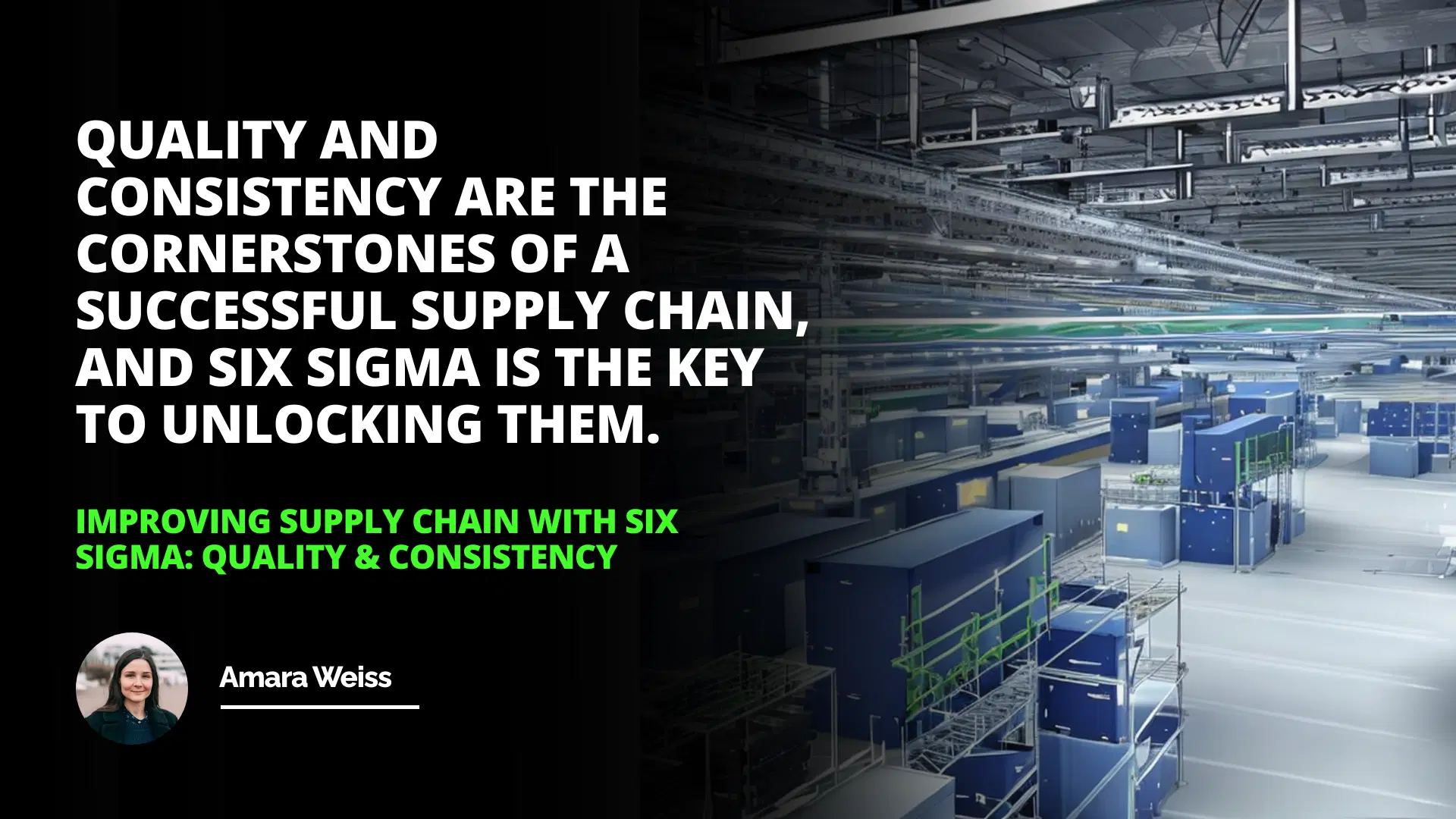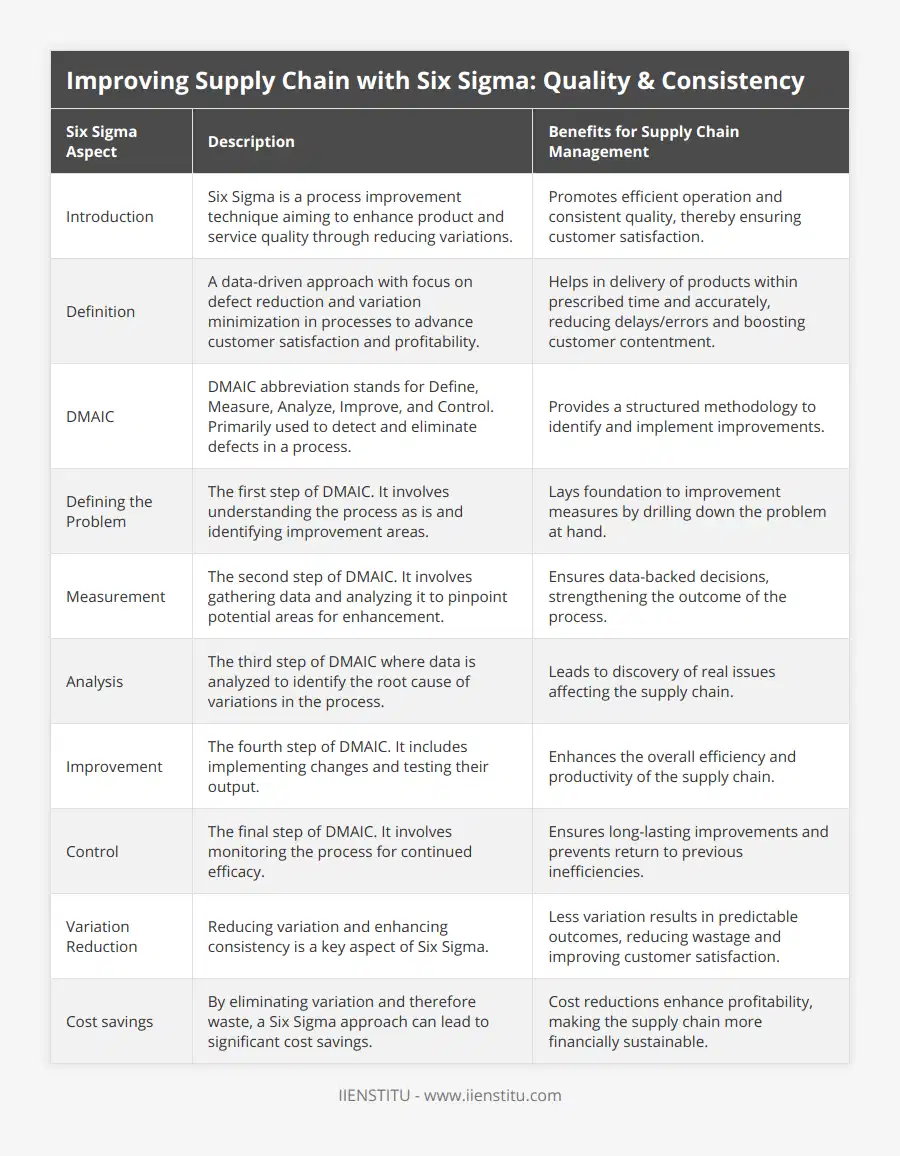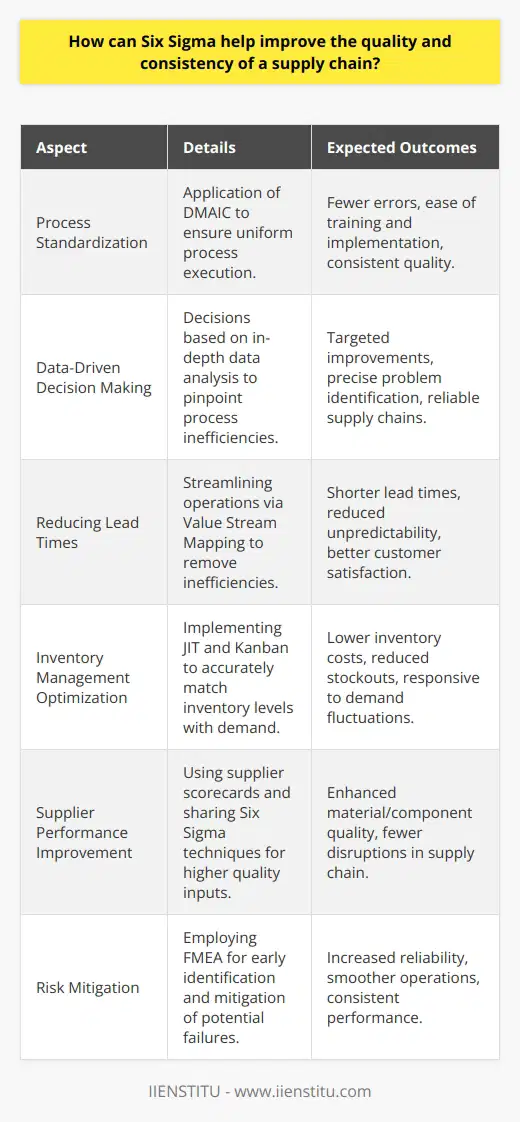
Six Sigma is a process improvement method used to reduce variation and improve the quality of products and services. It is based on Define, Measure, Analyze, Improve, and Control (DMAIC) and uses statistical methods to measure and analyze the variation in a process. Six Sigma has many benefits for supply chain management, including reducing costs, improving customer satisfaction, and increasing efficiency.
The Six Sigma implementation process is divided into five steps: Define, Measure, Analyze, Improve, and Control (DMAIC). These steps involve understanding the current processes, collecting data, analyzing the data, implementing changes, and monitoring the process to ensure it runs efficiently.
Introduction
What is Six Sigma?
Benefits of Six Sigma in Supply Chain
Six Sigma Implementation Process
Conclusion
Introduction: Six Sigma is a process improvement method used to improve product and service consistency, predictability, and quality. It is based on the concept that variation is awful and that consistent processes lead to high-quality products. Many companies use six Sigma to ensure their operations run smoothly and efficiently. In this article, we will discuss what Six Sigma is, the benefits of Six Sigma in supply chain management, the Six Sigma implementation process, and the conclusion.
What is Six Sigma?
Six Sigma is a process improvement method used to reduce variation and improve the quality of products and services. It is based on measuring the interpretation of a process and then using data-driven strategies to reduce that variation. Six Sigma aims to reduce the number of defects in a circle, leading to improved customer satisfaction and increased profitability.
Six Sigma is based on Define, Measure, Analyze, Improve, and Control (DMAIC). This process is used to identify and eliminate defects in a circle. Six Sigma also uses statistical methods to measure and analyze the variation in a circle.
Benefits of Six Sigma in Supply Chain
Six Sigma has many benefits when it comes to supply chain management. It helps to reduce costs, improve customer satisfaction, and increase efficiency. By reducing variation in the supply chain, Six Sigma helps to ensure that products are delivered on time and to the correct specifications. This helps to reduce the risk of delays and errors, leading to improved customer satisfaction.
Six Sigma also helps to reduce costs by eliminating waste and improving efficiency. By reducing variation and improving the consistency of processes, Six Sigma helps to reduce the amount of time and resources needed to complete tasks. This leads to cost savings for the company.
Six Sigma Implementation Process
The Six Sigma implementation process is divided into five steps: Define, Measure, Analyze, Improve, and Control (DMAIC).
The first step is to define the problem and set goals. This involves understanding the current processes and identifying areas of improvement.
The second step is to measure the process. This involves collecting data and analyzing it to identify areas of improvement.
The third step is to analyze the data and identify the root causes of variation. This helps to understand the underlying causes of the problem and identify potential solutions.
The fourth step is to improve the process. This involves implementing changes and testing them to ensure they are effective.
The fifth and final step is to control the process. This involves monitoring the process to ensure that it is running efficiently and that changes are effective.
Conclusion: Six Sigma is a process improvement method used to reduce variation and improve the quality of products and services. It has many benefits in supply chain management, including reducing costs, improving customer satisfaction, and increasing efficiency. The Six Sigma implementation process involves five steps: Define, Measure, Analyze, Improve, and Control (DMAIC). By following these steps, companies can ensure that their operations are running smoothly and efficiently, leading to improved customer satisfaction and increased profitability.
Quality and consistency are the cornerstones of a successful supply chain, and Six Sigma is the key to unlocking them.
Six Sigma is a widely accepted process improvement methodology that aids in enhancing the quality of products and services by reducing variations. It leverages a five-step approach called Define, Measure, Analyze, Improve, and Control (DMAIC) to cut down on defects, increase customer satisfaction, and boost profits. Its application in supply chain management is particularly beneficial in curtailing costs, heightening customer satisfaction, and escalating efficiencies. Companies are increasingly adopting Six Sigma to streamline operations and promote consistent quality and dependability in their supply chain. Additionally, online courses for logistics and supply chain management can be helpful for understanding and implementing Six Sigma techniques.

Frequently Asked Questions
How can Six Sigma help improve the quality and consistency of a supply chain?
Implementing Six Sigma within the supply chain can significantly benefit organizations, as it can help improve the quality and consistency of the supply chain. Six Sigma is a process improvement methodology that focuses on reducing defects and optimizing processes by utilizing data and statistical analysis. Six Sigma aims to reduce variability and ensure that operations are as efficient and effective as possible.
Six Sigma can be used to improve the quality and consistency of the supply chain in several ways. First, it can help to reduce variability in the supply chain. Six Sigma provides a framework for identifying and removing sources of variability, thus allowing organizations to produce consistent products and services. Second, it can help to improve process efficiency. Using statistical analysis, Six Sigma can identify process inefficiencies and suggest ways to improve them. Third, it can help to optimize the supply chain. By utilizing data-driven analytics, Six Sigma can help organizations identify and exploit opportunities for supply chain optimization.
In addition to improving the quality and consistency of the supply chain, Six Sigma can also help to reduce costs. By reducing variability and improving process efficiency, Six Sigma can help organizations to reduce costs associated with errors, rework, and waste. Furthermore, Six Sigma can help organizations minimize inventory, freight, and transportation costs by optimizing the supply chain.
Finally, Six Sigma can also help to improve customer satisfaction. By improving the quality and consistency of the supply chain, Six Sigma can help organizations to provide better products and services to their customers, thus leading to an increase in customer satisfaction and loyalty.
In conclusion, Six Sigma can be an invaluable tool for organizations looking to improve the quality and consistency of their supply chain. By reducing variability, improving process efficiency, optimizing the supply chain, reducing costs, and improving customer satisfaction, Six Sigma can help organizations timprove their supply chain's overall performance

What are the steps involved in implementing Six Sigma in a supply chain?
Six Sigma is a widely used business strategy to reduce costs and improve the quality of products and services. It is a process-oriented approach that focuses on reducing waste and improving efficiency. Implementing Six Sigma in a supply chain can have a positive impact on the organization's overall performance.
The implementation of Six Sigma in a supply chain requires several steps.
The first step is to develop a clear understanding of the supply chain process. This involves analyzing the current process and identifying areas of improvement.
The second step is to define the desired outcomes of the Six Sigma implementation. This includes setting goals, defining metrics, and establishing standards.
The third step is to select the right tools and resources to help reach the desired outcomes. This includes choosing the right software, metrics, and tools to measure performance and identify areas of improvement.
The fourth step is to develop a Six Sigma team. This team should include members with the necessary skills and experience to implement the Six Sigma process successfully.
The fifth step is to develop a plan of action. This plan should include a timeline for the implementation, the resources needed, and the metrics used to measure success.
The sixth step is to implement the plan. This includes launching the Six Sigma process, training staff, and monitoring progress.
The seventh step is to measure the impact of the Six Sigma implementation. This involves collecting and analyzing data to assess the effects of the process on the organization's overall performance.
The eighth step is to make adjustments and refine the plan. This includes making changes and improvements to the process as needed.
Finally, the ninth step is to maintain the Six Sigma process. This includes monitoring performance and adjusting to ensure the process works as designed.
Implementing Six Sigma in a supply chain can positively impact the organization's overall performance. By following these steps, organizations can ensure that they are maximizing the advantages of Six Sigma and achieving their desired outcomes.

What are the benefits of using Six Sigma to improve a supply chain?
Organizations are increasingly turning to Six Sigma to help improve their supply chain performance. Six Sigma is a process improvement methodology focusing on reducing waste and increasing efficiency in an organization's operations. By applying Six Sigma principles to the supply chain, organizations can benefit from a more streamlined and efficient process for delivering goods and services.
The first benefit of using Six Sigma to improve the supply chain is increased efficiency. By using Six Sigma to identify areas of inefficiency, organizations can reduce their costs and improve the speed at which goods and services are delivered. This can help organizations increase their profit margins and improve customer satisfaction.
Another benefit of using Six Sigma to improve the supply chain is increased customer satisfaction. By implementing Six Sigma principles, organizations can streamline the process of delivering goods and services. This can lead to faster delivery times, improved quality, and fewer customer complaints.
Six Sigma can also help organizations reduce their costs. BOrganizationscan saves money on labor, materials, and transportation. By streamlining the supply chain process, Six Sigma can also help identify areas of waste, allowing organizations to reduce their overall costs.
Finally, Six Sigma can help organizations identify areas of risk and eliminate them. By using Six Sigma to identify potential threats, organizations can proactively address them and reduce the likelihood of costly errors.
In conclusion, using Six Sigma to improve the supply chain can provide organizations with several benefits, including increased efficiency, improved customer satisfaction, reduced costs, and better risk management. In addition, by applying Six Sigma principles to the supply chain, organizations can improve their overall performance and ensure that they deliver goods and services efficiently and cost-effectively.



